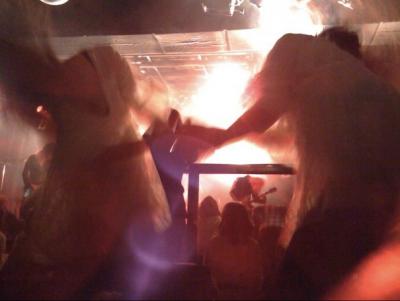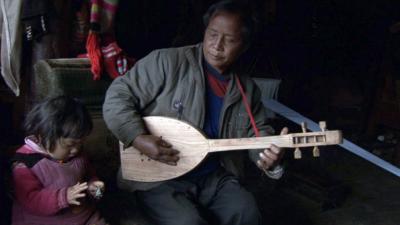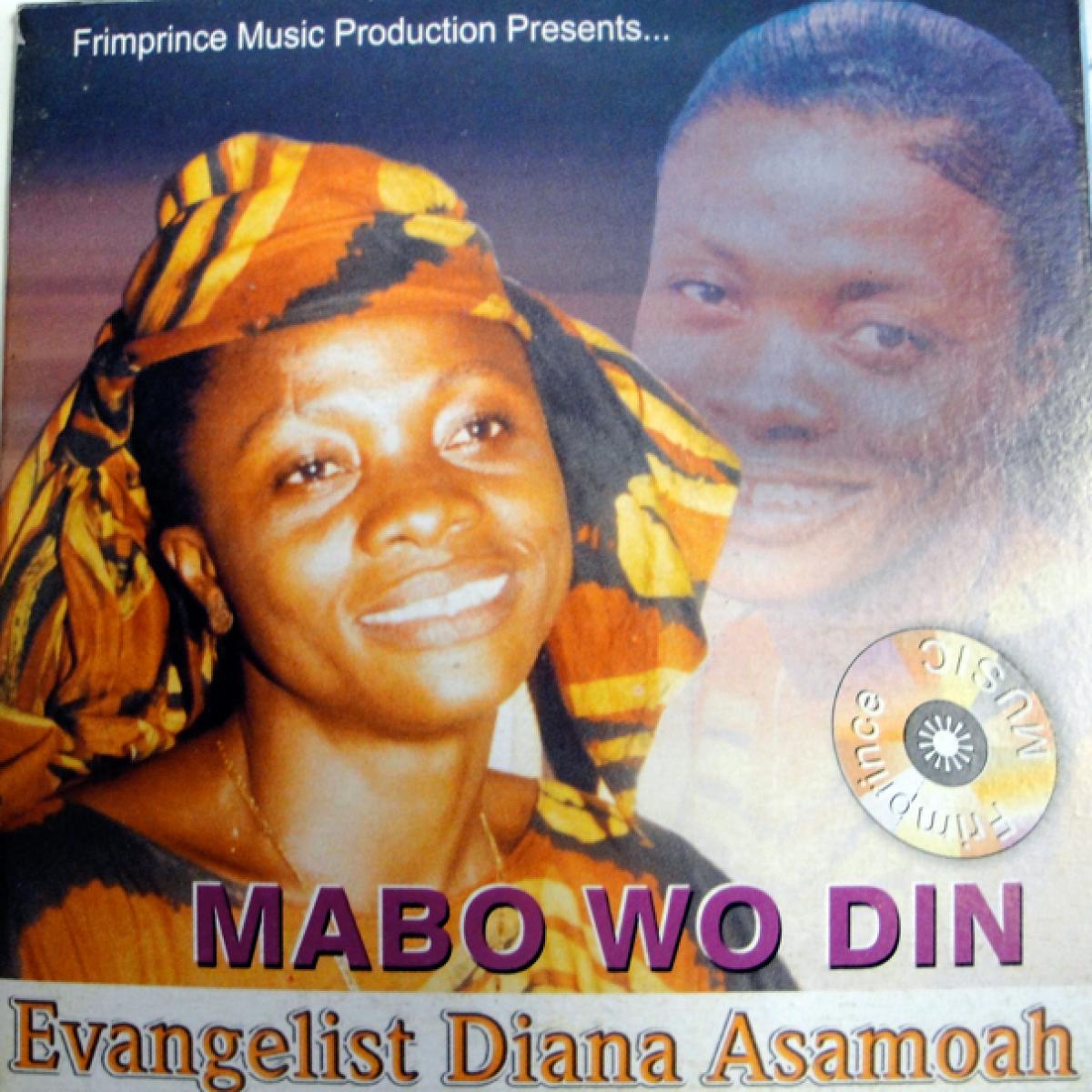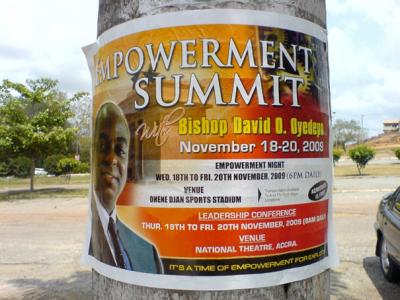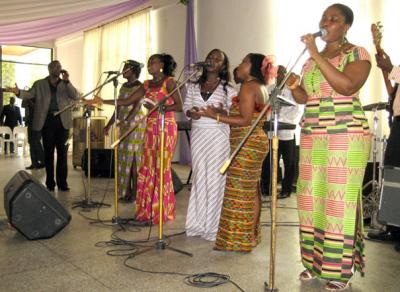Ghanaian Gospel Music, Born-Again Christianity, and the Nonconformity of the Ethnographer.
Brothers and sisters in Christ, make I tell you something: The world has nothing good for me. Dey go fi tell you say, make you come back. In fact, make you focus your mind, focus your eyes, follow Jesus, sotey! ‘Cause na he go give you better, better, better things! Na he go give you babies, na he go give you money, na he go give you anything that you want in this world!
(«Never Go Back», Evangelist Diana Asamoah feat. Adu Patrick)
Gospel music, today, is arguably the most thriving sector of commercial music production in Ghana, being widely visible and audible in the country’s public sphere and reaching deep into the domestic spaces of people’s everyday lives. In the Ghanaian context gospel refers to a conglomerate of styles with no clear-cut boundaries to other musical genres. Principally, any music can be made gospel through reference to Christian themes in the lyrics of songs. Styles range from more traditional dance-drumming types such as agbadza or adowa to popular guitar band music as well as its more recent electronic derivates. For the purpose of this paper, which more generally deals with the ethnography of gospel music and born-again Christianity in Ghana, I will concentrate on the latter styles of popular music that dominate Ghana’s mediascape. Most notably among these is gospel highlife which nowadays, in contrast to the classic guitar band highlife of the nineteen-sixties and seventies, often heavily relies on computer programming and synthesized sounds. The article explores the significance of gospel music in its socio-religious context and scrutinizes its role in the constitution of a cosmopolitan Pentecostal-Charismatic public sphere, stressing the centrality of gospel music performance in mediating between individual lifeworlds and global modernity through the use of both local and translocal idioms and styles.
The following discussion of the gospel phenomenon in Ghana will be framed by a critical reflection on ethnomusicological methodology. In this connection, it is particularly the notion of participant observation that will be scrutinized. More than just a methodology, ethnographic fieldwork has come to epitomize the identity of ethnomusicology as an academic discipline, constituting a crucial aspect of its practitioners’ professional self-understanding and often nourishing a profound sense of disciplinary difference (see Barz and Cooley 2008). My exploration of the ethnography of gospel music is necessarily shaped by my personal experience as a white, male researcher who in the Ghanaian context often represents the embodiment of the cultural and racial Other. It is also informed by my current status as an ethnomusicologist who has been trained in Germany and now finds himself in the Ghanaian academic system, teaching ethnomusicological theory and methodology to Ghanaian graduate students and being engaged in a critical dialogue about research methods with Ghanaian colleagues. In a sense, I personify the ambiguity of (music) ethnography in a postcolonial setting like Ghana.
While grounding the following discussion in my own fieldwork experience and ongoing research on gospel music in Ghana, I will, at the same time, try to avoid the self-indulgence and «narcissistic reflexivity of postmodern anthropology» that «tends to substitute the facile delights of self-exploration for the methodological confrontation with the gritty realities of the field» (Bourdieu 2003, 281–282). Instead, I want to argue for a move from the opportunistic and relativist stance of participant observation towards critical dialogue and what Pierre Bourdieu has called «participant objectivation» (ibid.). Before I proceed with my critical examination of methodology, a brief overview of born-again Christianity will help putting gospel music in Ghana into perspective.
Born-Again Christianity in Ghana
The prominence of gospel music can only be understood against the backdrop of the spectacular growth of Pentecostal-Charismatic churches over the course of the past decades, a phenomenon that is not restricted to Ghana but which is part of a larger transnational movement (e.g., Coleman 2000; Gifford 1998, Meyer 2004; Robbins 2004). The roots of Pentecostalism are usually traced back to the so-called Azusa Street revival that was initiated in Los Angeles by the African American preacher William J. Seymour at the beginning of the twentieth century (Robbins 2004, 120). In the West African context, however, the prophetic movement of the early twentieth century that led to the establishment of a number spiritual or so-called African Independent Churches had an equally important impact on its development (Amanor 2004, 13–19). The more recent success of Charismatism in Ghana found an important breeding ground in the political and economic crisis of the nineteen-seventies and eighties, and the subsequent submission to structural adjustment programs imposed by the International Monetary Fund and the World Bank (Gifford 1994 and 2004, 3–6). While a distinction can be made between older Pentecostal churches that emerged in the first half of the twentieth century and newer Charismatic denominations that emerged in the past three to four decades (sometimes also called Neo-Pentecostal), all these types of evangelical Christianity share forms of worship and a common set of believes. These include the believe in the need for personal conversion (to be «born again»), biblical inerrancy, and the emphasis of spontaneous inspiration by the Holy Spirit, expressed through spiritual gifts like miracles, healing, prophecy, and speaking in tongues (glossolalia).
Many Charismatic churches in Ghana, today, maintain strong ties to the transnational networks of Pentecostal-Charismatic Christianity, particularly Nigerian and American televangelists, and they are also interlinked with the networks of the Ghanaian diaspora (Akyeampong 2000, 204–213). Born-again Christianity permeates all spheres of Ghanaian society, though particularly the new mega-churches in the urban areas seem to disproportionally attract young, educated and upwardly mobile people (De Witte 2003, 178–182; Meyer 2004, 260). Some of these, such as Mensa Otabil’s International Central Gospel Church or Nicholas Duncan-Williams’ Action Chapel International, draw several thousand people to the Sunday services at their main branches in Accra (Gifford 2004, 23–27). Charismatism has, at the same time, penetrated other strands of Christianity so that «there is not a Christian church in Ghana or Nigeria that has not been affected by the revivalist trends of the last few decades» (Hackett 1998:265). Through the extensive appropriation of media technology, Charismatic Christianity is now inseparably intertwined with Ghanaian popular culture. The leaders of the highly mediatized mega-churches are public figures, preaching and performing «miracles» on radio and in TV programs that are produced by their own media companies (De Witte 2003; Hackett 1998).
It has been stressed that music and dance play a central role in Charismatic worship (e.g., Gifford 2004, 35) and they also feature prominent at so-called «crusades» and «gospel revivals» that very much resemble pop concerts. As Rosalind Hackett remarked, «music is […] one of the most important ways in which the charismatics construct their own identity and invade space» (1998, 263). The cassettes, CDs, and music videos of gospel stars such as Christiana Love, Diana Asamoah, Philipa Baafi, Kwaku Gyasi, Ohemaa Mercy, or Ernest Opoku, to name just a few, are promoted on radio and TV. Gospel bands in the churches take up their favorite songs and perform them in Sunday services. Gospel recordings are played back on sound systems at social functions such as weddings and funerals, or by shop owners to attract customers to their stores. Overall, the emergence and pervasive public presence of Pentecostal-Charismatic Christianity has gradually blurred the distinction between the religious and the secular realm.
Witnessing a Charismatic Worship Service
The first time I witnessed a Charismatic church service was in the Ghanaian diaspora. The so-called Gospel Believers Center International was one among at least a dozen Ghanaian-initiated churches in Berlin and worshipped every Sunday in the Church at Südstern in Kreuzberg. The wife of a Ghanaian store owner whom I had told about my interest in gospel music directed me there. When I entered the church one afternoon in March 2004, the congregation had split up into smaller bible study groups, which were busily engaged in the discussion of a particular bible passage. I was welcomed by a woman wearing a sash on which the word «usher» was boldly written. She asked me whether this would be my first time attending their service, provided me, when I affirmed, with the «Vision Statement» of the church that included a registration form for prospective members, and then guided me to a seat in one of the back rows. After the bible study groups had finished, people went to their seats and a band – made up of a drum set, bass guitar, keyboard, and saxophone – started playing. The whole service consisted more or less of music-making. The band accompanied a vocal quartet that led the congregation, their style being reminiscent of North American gospel music. The first part of the service was a «worship» section, the music being overall mellow and slow, where people sang, prayed with their hands lifted up into the air, some bowing down in devotion, others braking out in tears, or speaking «in tongues». This was followed by an upbeat «praise» section, the music being faster and more joyful, with people dancing, singing and shouting phrases like «Praise the Lord!». There was no hymn book, but the lyrics of the songs, all in English, were projected onto a large screen in front, so that those unfamiliar with them could also sing along.
In accordance with the Gospel Believers’ ambitious evangelical aspirations to build a multicultural and truly international church, the language employed in the service was English rather than Ghana’s most widely spoken lingua franca Twi (Akan), thus, attracting Africans from other Anglophone countries as well as a few Germans in addition to the otherwise predominantly Ghanaian following. In the sermon – the virtually only non-musical part of the service – the pastor spoke about the «divine weapons» each of us possessed, shouting repeatedly: «You have divine weapons! You have divine weapons!» These, he told us, had to be activated through prayer and fasting to protect ourselves from the «demonic forces» that, according to his vivid account, seemed to lurk just about everywhere. As my first personal encounter with the expressive forms of Charismatic Christianity, I must honestly say that the whole experience made me feel slightly uncomfortable, especially the, at times, aggressive tone of the sermon with its militaristic metaphors and the strong fixation on the demonic. Pentecostal-Charismatism’s fundamentalist worldview, the belief in biblical inerrancy, creationism, and generally its anti-intellectualist stance, was not only completely at odds with my rather agnostic, liberal mindset, but directly challenged it and seemed, at first, irreconcilable with the critical rationalism of scientific research.
From Participant Observation to Participant Objectivation
In African studies more generally, Charismatic churches «with their intensive links to transnational circuits, in particular to American televangelists, and their enthusiastic drive to proselytize nonbelievers (researchers included), were», as Birgit Meyer noted, «difficult to accept as viable objects of study» (2004, 448). This might also explain the relative paucity of studies of the gospel phenomenon in Ghana. Those studies that deal with gospel music primarily present narrative historical accounts of the development of Christian music in Ghana over the course of the twentieth century, examining it within an analytical framework that stresses processes of «Africanization» (Atiemo 2006; Collins 1996, 177–188; 2002, 12–13 and 2004). Gospel music both in the context of Charismatic worship as well as in its commercialized, mediated forms and formats, seems to represent one of those fields of popular cultural production that have long been written off in Africanist scholarship because they resist and ultimately dissolve distinctions between «indigenous», genuinely «African» cultural forms and those held to convey a «Western» or «modern» influence (see Barber 1997). With regard to Ghanaian gospel, what is overall lacking are more detailed ethnographic analyses of the ways in which people make sense of and use music in the context of their everyday lives.
Quite apart from conceptual problems that ethnographic fieldwork in translocal, media-saturated contexts brings about, which have been discussed at length elsewhere (e.g., Abu-Lughod 1997; Gupta and Ferguson 1997; Marcus 1995), there are more practical methodological problems that an ethnomusicology of Christianity faces. As Jeff Todd Titon pointed out, «fieldwork undertaken among religious groups by ethnomusicologists who are atheists or who hold religious beliefs that differ from their informants’ beliefs» poses «acute problems of stance and identity» (1985, 19) on the part of the researcher. Particularly empathetic notions of participation, as highlighted in the recent «experiential turn» in musical ethnography with its call for «a truly participatory participant observation» (Barz and Cooley 2008, 4), seem problematic in this connection, since «true participation» in the case of Pentecostalism would, as Titon (1985, 22) noted, actually mean conversion. Moreover, the emphasis on experiential reflexivity in music ethnography tends to construct «music participation as a privileged realm», which, as Michelle Bigenho convincingly argued, «works hand in hand with an ethnocentric ideology that affords music an autonomous space» (2008, 30). It seems necessary, therefore, to develop a notion of participant observation that is based less on the romantic ideal of intuitive, empathetic immersion into a different cultural reality, understood as an integrated whole, but more on a practical notion of participant observation as method, where the ethnographer enters a given social field over a period of time and, through observation, interaction and various forms of participation, comes to terms with his/her role and stance vis-à-vis that of other actors in the field.
My own way into the field of Ghanaian Charismatic Christianity, apart from occasional earlier encounters, opened up when I permanently moved from Germany to Ghana in 2006. The first consequence was an increase in mere exposure to gospel music and the soundscape of Charismatic Christianity, which is not restricted to Sunday services but includes regular prayer meetings of congregations throughout the week as well as the popular «all-night» services that usually take place on Friday nights and last until Saturday dawn. On holidays like Christmas and Easter, «crusades» and «revivals» are organized both in churches as well as in open spaces, usually lasting several days and often attracting large crowds. All these activities are widely audible and – as congregations also worship open-air and sometimes in uncompleted structures – visible in public space. In addition, I was frequently invited by people to witness their worship service, which gave me a sense of the differences and similarities between various churches—and, eventually, I even got married in a Charismatic church, involving myself on a regular basis in the activities of my wife’s church, Christ Victory Ministries, a smaller Charismatic congregation that worships in Nungua, Accra, over the course of two and a half years between 2006 and 2009. While I witnessed church activities such as prayer meetings and deliverance sessions that are held during the week, my participation in church life was mainly as an ordinary attendant of Sunday services. I also witnessed rehearsals by the choir and gospel band of the church, but I did not actively participate as a musician in these groups. Like the majority of the other congregation members, I restricted my musical participation to dancing, clapping and singing during worship services.
Gaining access to the church through my wife, who was an active member at the time we got to know each other, had advantages for me in at least two regards. First, my presence at church programs and services seemed – even though I was the only «white man» (Twi: oburoni) in the church – quite natural and I did not have to explain my presence over and over again. Second, other members of the congregation knew that my prime reason for being in the church was my wife and our wish to worship together, and it was quite clear to them that I am not a Charismatic myself (though some might have assumed I was gradually converting). While the pastor and other officials in the church knew about my research interest in Charismatic Christianity and readily shared their views and knowledge, my identity as husband and more «orthodox» Christian (i.e., German Lutheran) made possible a dialogue with congregation members in which we could talk about differences and similarities of believe and religious experience at the same time that there remained a certain distance between us. In contrast to the stereotypical anthropologist portrayed by Claude Lévi-Strauss, «who is a critic at home and a conformist abroad» (1992, 386), I always maintained my initial critical stance towards Charismatism’s fundamentalist worldview at the same time that the distinction between home and abroad became more and more obsolete.
Thus, the avenue that eventually presented itself for my research on gospel music, particularly when I became more familiar with Ghanaian social discourse in general, was to enter into a critical dialogue with Charismatic Christians (and others) about their as well as my own religious and musical experiences. Such critical dialogue is predicated on the assumption that both researcher and researched share a common social space (Berger 2008), a stance that implicitly undermines anthropological constructions of «the field» as a conceptual elsewhere and a «highly overdetermined setting for the discovery of difference» (Gupta and Ferguson 1997, 5). It is Thomas Csordas who reminds us that, despite the now mostly taken-for-granted call for reflexivity in ethnography, «ethnographic reflexivity [seldom] fully take[s] into account the reflexivity of the other» (Csordas 1997, xi). As far as music ethnography is concerned, rather than «locating the reflexive moment in shared music performance» (Barz and Cooley 2008, 20) and, thus, implicitly presuming that there is an unbridgeable gap between language and (musical) experience, I would follow Csordas in his argumentation that «language is not only a form of observable behavior, but a medium of intersubjectivity, so that it is fair to say that language gives us authentic access to experience» (1997, xii). Whose experience are we talking about in our ethnographic accounts, after all?
To engage in critical dialogue with our research participants we have to reframe reflexivity in ethnography as what Csordas calls the «dialogue of reflexivities» (1997, xi). Since there is an implicit danger in such an analysis of merely reproducing native discourse, there is at the same time the need, as Csordas writes, «for methodological care in setting up the relation between theory and phenomena» (1997, xii). The kind of reflexivity that is needed on the part of the researcher is then not so much the experiential reflexivity that characterizes writings in so-called performative or auto-ethnography, but the kind of meta-reflexivity that Pierre Bourdieu has called «participant objectivation». As he explains: «By ‹participant objectivation›, I mean the objectivation of the subject of objectivation, of the analysing subject – in short, of the researcher herself» (2003, 283; original emphasis). In contrast to the textual reflexivity that has been fostered particularly in North American cultural anthropology, participant objectivation is not meant to help us «to explore […] the ‹lived experience› of the knowing subject but the social conditions of possibility […] of that experience and, more precisely, of the act of objectivation itself» (2003, 282). It is on this methodological basis that we should now be ready to engage in a critical dialogue about the meaning of gospel music and its role in the mediation of global modernity.
Success Stories: Performing the Gospel of Prosperity
One of the most pervasive themes in gospel highlife is personal success, mostly framed through narratives about material prosperity and the accumulation of wealth (see also Atiemo 2006:154). The preoccupation with material wealth goes hand in hand with the so-called «gospel of prosperity» that features prominently in the materialistic theology adopted by Pentecostal-Charismatic churches. More generally, prosperity coupled with a «strong global inclination» (Meyer 2004, 453) are two elements that clearly distinguish Charismatism from other Christian paradigms. Narratives about personal success are highlighted in many gospel songs. The song «Never Go Back», quoted at the outset of this article, for instance, suggests that through faith and by following Jesus, the born-again Christian will eventually get anything s/he wants, including babies (fertility) and money (Asamoah 2009). Other songs tell a similar story. Ohemaa Mercy’s «Wobɛyɛ kɛseɛ», published on the same-titled album (Mercy 2009), promises the listener that she will be «big/great» (i.e. successful) and become a blessing (wobɛyɛ kɛseɛ, wobɛyɛ nhyira o). In the same vein, Christiana Love tells us in one of her songs that through Jesus Christ, she is «moving forward» (Love 2008).
The message of «moving forward» without looking back is related to another pervasive theme of Charismatism, which is transformation (Robbins 2004, 127–130). As Birgit Meyer (1998) explained in further detail, Pentecostal churches often ask their members to «make a complete break with the past», a transformation that is dramatized in «rituals of rupture» (Robbins 2004, 128), thus, constantly revisiting the moment of conversion (i.e., to be born-again) through an elaborate ritualization of discontinuity. I vividly remember a service at Christ Victory Ministries, where the pastor at some point asked the congregation to symbolically cut all ties with the past, particularly family ties, since the extended family (Twi: abusua) in Ghana is often associated with witchcraft and thus thought to block people’s individual progress (see also Meyer 1998). We were asked to form scissors with the index and middle finger of our right hand and cut the imaginary umbilical cord that symbolically connected us with our past and allegedly held us back from success. Coupled with the message of success, this moment of transformation is also addressed in gospel songs. One example is Philipa Baafi’s «Go High» (Baafi 2007). While Baafi’s song, like those discussed above, foregrounds a narrative of personal success, the enactment of the narrative of the song in the video clip is revealing (Baafi n.d.). The clip sets out with a scene in a village where Baafi tells the villagers not to be content with where they are. As the song proceeds, the traditional instruments – drums and a xylophone – that feature in the village scene are successively substituted by electric guitars, keyboard and trumpets and the dressing of the protagonists changes from traditional cloths into modern fashion.
Gospel artists themselves are an integral part of their message. As public figures, they are important nodes of identification for audiences. Their role in the efficacy of the message of prosperity and individual socioeconomic success through self-transformation is in many ways analogous to the figure of the charismatic pastor. As Meyer comments: «The figure of the charismatic pastor […] dressed in exquisite garments and driving a posh car pinpoints that prosperity and being born-again are held to be two sides of the same coin» (Meyer 2004, 459). While prosperity in the Pentecostal context is seen as an expression of divine grace (Twi: adom), charismatic figures like pastors as well as successful gospel artists can be seen as embodiment of that message and are understood by people as a kind of «living testimony». The meaning people derive from gospel music, often described in general terms as «motivational» or «inspirational», is then not exclusively, and perhaps not even primarily found in the lyrics of songs. Beyond the immediate level of semantic meaning, gospel can better be understood as a mindset, as a whole way of life for which gospel artists exemplarily stand, since «gospel musicians are supposed to display a certain type of lifestyle». Interview partners related, for instance, their personal experience with the song «Afunumu Ba» by Cicilia Marfo (Marfo 2010), one of the most successful Ghanaian gospel songs of 2010/11, recalling how the singer was interviewed on TV, telling the viewers how she first «suffered’» in life and then became successful through divine intervention.
In various media interactions as well as during live performances, Marfo keeps retelling her story which seems to particularly draw people to her music (see also Cicilia Marfo 2010). As one interviewee remarked: «I heard about her life story and that is what made me so passionate about the song». It is, then, through the personal involvement of their audience that artists like Marfo are able to project their message of personal success, telling listeners not just that they «made it» but, as another respondent put it, implying that «you, too, you will also become like me».
Yet on another level, the question about the meaning of gospel music in a narrow, semantic sense, is misleading. Quite apart from questions of signification, from a Charismatic point of view music does not so much represent something external to it, i.e. convey referential meaning, but actually constitutes a spiritual reality in itself. As much as words are believed to have a spiritual life of their own – as one pastor in a sermon put it: «Words are spirits» – musical utterances are a spiritual reality as well. In the context of Charismatic worship, music has therefore more than just a functional or decorative role to play. Rather, it is believed that gospel music imparts the Holy Spirit to the whole congregation, which is one of the reasons why especially singers in the church are expected to adhere to high moral standards and live exemplary, «holy» lives. Impurity on the part of performers could have an immediate negative spiritual impact on other members of the congregation. Within Charismatic theology there is an elaborate «demonology» that deals with evil spirits, witches and other demonic powers (Meyer 1995) that can afflict people and from which born-again Christians have to actively protect themselves. The performance of gospel music is one means to do so and can, in this sense, quite literally be understood as an anti-demonic device. Beyond gospel music’s mere «inspirational» or «motivational» nature, the performance of gospel music is then itself a ritualization of discontinuity, a (potentially) transformational act and a direct expression of the presence of the Holy Spirit.
The Pentecostal-Charismatic Public Sphere and the Mediation of Modernity
In this last section I want to look more specifically at the two extreme ends of the transformation born-again Christians undergo, and discuss the role of gospel music in the constitution of the Pentecostal-Charismatic public sphere. At one end of the transformation enacted in gospel music we are confronted with an imagery that indexes individual success and that conveys a specific idea of global modernity. The symbolism that is invoked, for instance, in gospel music videos comes in the form of luxurious mansions, expensive cars and clothes, jewelry, and the freedom to travel (particularly to Western countries). As it has more generally been observed, with its emphasis on prosperity and its global aspirations, «pentecostalism provides an imaginary space in which people may address their longing for a modern, individual and prosperous way of life» (Meyer 1999, 163). At the other extreme, we find the realm of the local and traditional, associated with witchcraft, «fetishism», and an outmoded, backward, rural past. Part of this domain is the extended family as well as traditional religion and the traditional political system with its ideals of communalism and reciprocity. These ideals seem directly opposed to and in many ways incompatible with the ideal of individual accumulation and the extreme material prosperity propagated by Charismatism.
As much as born-again Christians aspire to «a modern, individual and prosperous way of life», the lure of modernity is itself ambivalent and in a spiritual sense potentially dangerous. As a matter of fact, in the West African context individualistic accumulation and consumption are themselves suspicious and often associated with occult or satanic practices (Meyer 1995). Moreover, the same imagery of modernity we are confronted with in gospel music also features prominently in other West African media contexts such as popular Nigerian and Ghanaian video films (see Meyer 2008; Haynes 2000) as well as in secular highlife music, particularly the so-called burger highlife that emerged in the 1980s (Carl 2014). While it is the same status symbols that we find here (luxurious cars, houses, clothes etc.), in contrast to gospel, where they index divine grace, in the context of secular highlife they are associated with worldly things like clubbing, drinking, and prostitution (Collins 1996, 179). This ambivalence of modernity finds an expression in the discourse on gospel music in the way in which people discuss the style of individual gospel artists, style understood here in a very broad sense including musical style but also ways of dressing, dancing, bodily gestures and modes of speech. In discussing individual artists’ styles, people held, for instance, that particularly female gospel artists should always look «neat and presentable», but not tantalizing. The style of individual singers such as Christiana Love or Philipa Baafi, particularly their body movements and dressing, were felt to be «too extravagant», «pompous», or even sexually provocative by some. Moreover, the difference between telling the story of one’s own success and accumulation of wealth on the one hand, and, on the other, an attitude of selfish display of one’s wealth and achievements is not always clear. The borderline between what from a Charismatic point of view is impeccable and considered «holy», and what is seen as morally corrupt, sinful, or selfish, is rather thin. In this sense, we might say that the Ghanaian discourse on gospel music is also framed by an «ethics of style», much in the same way as it has been described by Timothy Rommen in the context of the Trinidadian Full Gospel community (Rommen 2007).
While discussions of the individual style of gospel artists underline the ambivalent stance of Pentecostalism towards the market economy and Western patterns of consumption, the discourse on gospel music constitutes at the same time an important means in the demarcation between Western modernity and born-again Christianity, and it plays, therefore, a crucial role in the constitution of the Pentecostal-Charismatic public sphere. It has been noted that Charismatism provides people with forms of popular culture that are «safe for consumption by ‹born-again› Christians» (Hackett 1998, 258), setting up a moral space within which they can engage with global modernity without necessarily subscribing to its supposedly negative, corrupting effects. In this sense, the Pentecostal-Charismatic public sphere can be understood as a counterpublic to both the discourse of Western rationalism as well as the realm of local tradition which, while also setting itself apart from Western modernity, is rejected by African Christians for its «pagan» implications. By drawing on a range of musical styles, including North American gospel music, reggae, soul, R&B, Nigerian and South African popular music, as well as through the use of modern musical instruments and production technology, gospel music in Ghana establishes itself as a decidedly translocal cultural form. At the same time, these stylistic influences are channeled through more familiar local idioms—patterns of Ghanaian highlife music, popular dancing styles, African fashion, as well as the employment of predominantly Twi in the lyrics of songs, with the occasional interspersion of other Ghanaian languages such as Ga and Ewe as well as English and Nigerian pidgin.
As a constitutive feature of the Pentecostal-Charismatic public sphere, gospel music, then, transcends the local at the same time that is sets itself apart from secular modernity. As a transnational phenomenon, the public sphere of Charismatism might be understood as an alternative or “parallel modernity” (Larkin 1997), as it draws on «transnational cultural flows [that] emerge from many centers and flow into many peripheries» (ibid., 434). Joel Robbins (2004, 130–31) has more generally suggested that Pentecostal-Charismatism’s global success might have to do with its ability to connect with transnational discourses and translocal expressive forms while at the same time rooting itself in local communities and fostering a high degree of active participation of its followers. Not least in this last regard, gospel music has, as we have seen, a central role to play, as its performance opens multiple ways of participation and identification for people, connecting them with the transnational sphere of born-again Christianity at the same time that they remain grounded in the local.
Conclusion
In the foregoing discussion I have highlighted the significance of gospel music in Ghana and argued for its crucial role in the constitution of a cosmopolitan Pentecostal-Charismatic public sphere. I have stressed the centrality of gospel music performance in the mediation between individual lifeworlds and global modernity, establishing itself as a translocal musical field at the same time that it remains rooted in the local. Gospel music derives its dual nature from drawing on diverse translocal musical influences that are channeled through more local idioms and styles. It thus speaks to the concerns of local audiences, creating a counterpublic to both the realm of Western rationalism as well as the allegedly anachronistic spaces of tradition and providing people with meaningful expressive forms to address the ambivalences associated with global modernity. As such, gospel music is an important medium in the ongoing negotiation of people’s identities and a crucial aspect in the creation of «moral self [that is] not misled by the glitzy world of consumer capitalism nor misguided by the outmoded world of tradition, but instead filled with the Holy Spirit» (Meyer 2004, 460).
I also discussed ethnomusicological methodology, taking the study of gospel music and born-again Christianity in Ghana as a case in point that calls conceptualizations of «the field» as integrated whole and empathetic notions of participation into question. Instead of the opportunistic and relativist stance that often characterizes participant observation in «reflexive ethnography», I suggested that a critical «dialogue of reflexivities» (Csordas 1997, xi) as well as what Bourdieu (2003) has called «participant objectivation» might help to come to terms with the fact that the analyzing subject and the subjects of research share a common social space, developing, at the same time, a more objective approach to the social realities within which ethnomusicologists today arguably work. It seems that ethnographic work in translocal, media-saturated contexts is predestined to move us towards the representation sameness rather than difference, since those we represent are «part of the same cultural worlds we inhabit—worlds of mass media, consumption, and dispersed communities of the imagination» (Abu-Lughod 1997, 128). While I still think that ethnography provides valuable tools for in-depth micro-sociological analysis and allows us to pose questions we would otherwise not be able to ask, we might, after all, have to reconsider our role as «specialists of difference» (Gupta and Ferguson 1997, 2) and start advocating a higher degree of methodological experimentation to come to terms with the changing social conditions within which we work.


